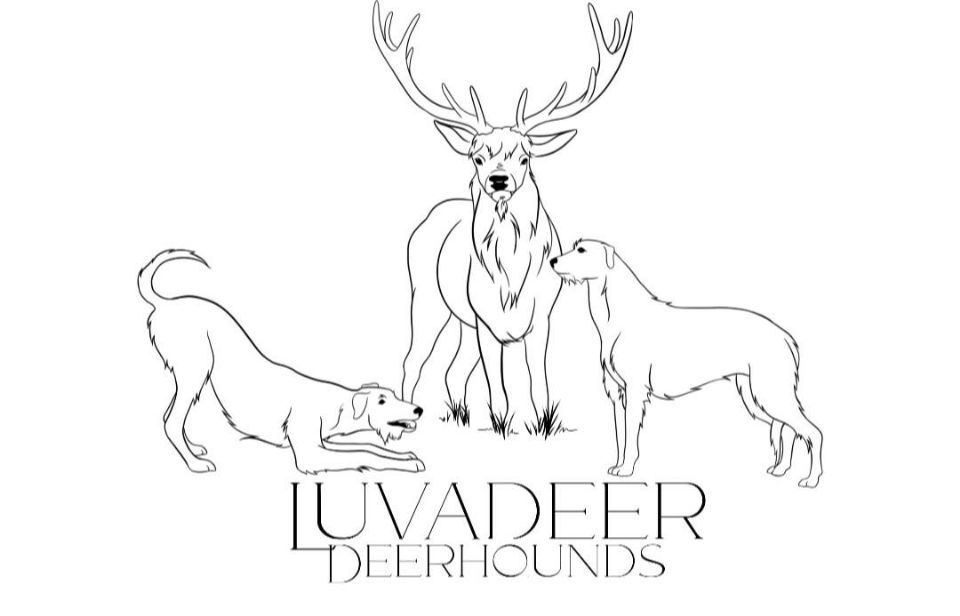The Deerhound standard
Sub-links for this page
Deerhound
A breed standard is the guideline which describes the ideal characteristics, temperament, and appearance of a breed and ensures that the breed is fit for function with soundness essential. Breeders and judges should at all times be mindful of features which could be detrimental in any way to the health, welfare or soundness of this breed.
Last updated: 17 Nov 2009

Kennel Club, London 1994
FCI Standard No 164
-
Group:Group 4 (Hounds)
-
-
General Appearance:
Resembles a roughcoated greyhound of larger size and bone.
-
Characteristics:
The build suggests the unique combination of speed, power and endurance necessary to pull down a stag, but general bearing is one of gentle dignity.
-
Temperament:
Gentle and friendly. Obedient and easy to train because eager to please. Docile and good tempered, never suspicious, aggressive or nervous. Carries himself with quiet dignity.
-
Head And Skull:
Broadest at ears, tapering slightly to eyes, muzzle tapering more decidedly to nose, lips level. Head long, skull flat rather than round, with very slight rise over eyes, with no stop. Skull coated with moderately long hair, softer than rest of coat. Nose slightly aquiline and black. In lighter coloured dogs black muzzle preferred. Good moustache of rather silky hair and some beard.
-
Eyes:
Dark. Generally dark brown or hazel. Light eyes undesirable. Moderately full with a soft look in repose, but keen, far-away look when dog is roused. Rims black.
-
Ears:
Set on high and in repose folded back. In excitement raised above head without losing the fold and in some cases semi-erect. A big thick ear hanging flat to the head or a prick ear most undesirable. Ear soft, glossy and like a mouse's coat to the touch; the smaller the better, no long coat or fringe. Ears black or dark coloured.
-
Mouth:
Jaws strong, with a perfect, regular and complete scissor bite, i.e. the upper teeth closely overlapping the lower teeth and set square to the jaws.
-
Neck:
Very strong with good reach sometimes disguised by mane. Nape of neck very prominent where head is set on, no throatiness.
-
Forequarters:
Shoulders well laid, not too far apart. Loaded and straight shoulders undesirable. Forelegs straight, broad and flat, a good broad forearm and elbow being desirable.
-
Body:
Body and general formation that of a greyhound of larger size and bone. Chest deep rather than broad, not too narrow and flat-sided. Loin well arched and drooping to tail. Flat topline undesirable.
-
Hindquarters:
Drooping, broad and powerful, hips set wide apart. Hind legs well bent at stifle with great length from hip to hock. Bone broad and flat.
-
Feet:
Compact and well knuckled. Nails strong.
-
Tail:
Long, thick at root, tapering and reaching almost to ground. When standing dropped perfectly straight down or curved. Curved when moving, never lifted above line of back. Well covered with hair; on upper side thick and wiry, on under side longer, and towards end a slight fringe is not objectionable. A curl or ring tail undesirable.
-
Gait/Movement:
Easy, active and true, with a long stride.
-
Coat:
Shaggy, but not overcoated. Woolly coat unacceptable. The correct coat is thick, close-lying, ragged; harsh or crisp to the touch. Hair on body, neck and quarters harsh and wiry about 8-10 cms (3-4 ins) long; that on head, breast and belly much softer. A slight hairy fringe on inside of fore and hind legs.
-
Colour:
Dark blue-grey, darker and lighter greys or brindles and yellows, sandy-red or red fawns with black points. A white chest, white toes and a slight white tip to stern are permissible but the less white the better, since it is a self-coloured dog. A white blaze on head or white collar unacceptable.
-
Sizes:
Minimum desirable height: Dogs 76 cms (30 ins) at withers
Bitches 71 cms (28 ins) at withers
Weight: Dogs about 45.5 kgs (100 lbs)
Bitches about 36.5 kgs (80 lbs) -
Faults:
Any departure from the foregoing points should be considered a fault and the seriousness with which the fault should be regarded should be in exact proportion to its degree and its effect upon the health and welfare of the dog.
-
Notes:
Male animals should have two apparently normal testicles fully descended into the scrotum.
Taken from the ANKC website
